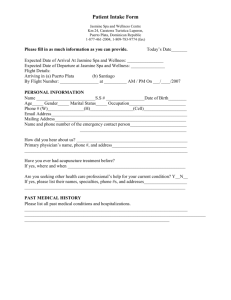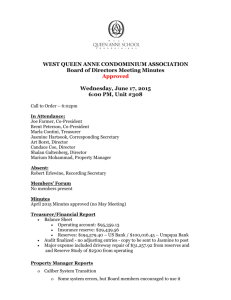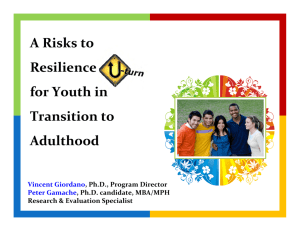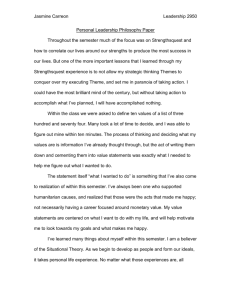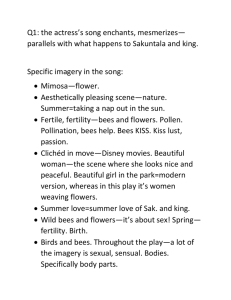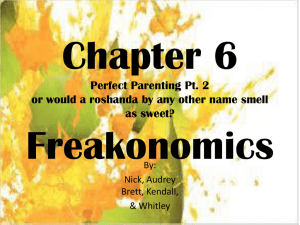AAE 5-1-2012 Class Notes
advertisement
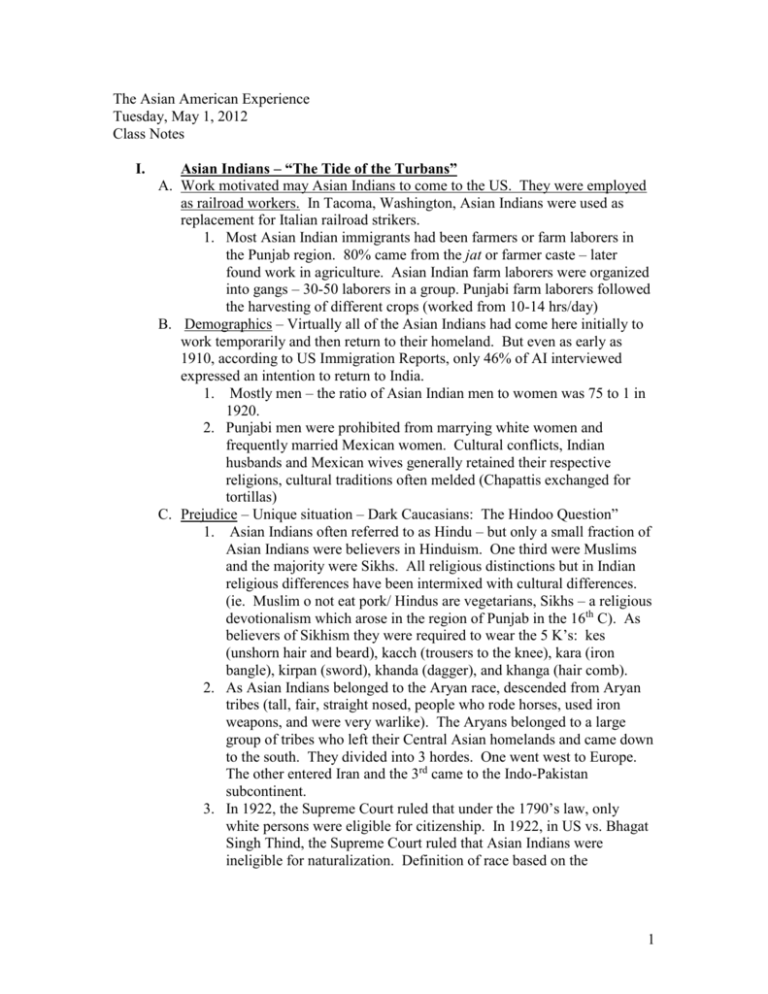
The Asian American Experience
Tuesday, May 1, 2012
Class Notes
I.
Asian Indians – “The Tide of the Turbans”
A. Work motivated may Asian Indians to come to the US. They were employed
as railroad workers. In Tacoma, Washington, Asian Indians were used as
replacement for Italian railroad strikers.
1. Most Asian Indian immigrants had been farmers or farm laborers in
the Punjab region. 80% came from the jat or farmer caste – later
found work in agriculture. Asian Indian farm laborers were organized
into gangs – 30-50 laborers in a group. Punjabi farm laborers followed
the harvesting of different crops (worked from 10-14 hrs/day)
B. Demographics – Virtually all of the Asian Indians had come here initially to
work temporarily and then return to their homeland. But even as early as
1910, according to US Immigration Reports, only 46% of AI interviewed
expressed an intention to return to India.
1. Mostly men – the ratio of Asian Indian men to women was 75 to 1 in
1920.
2. Punjabi men were prohibited from marrying white women and
frequently married Mexican women. Cultural conflicts, Indian
husbands and Mexican wives generally retained their respective
religions, cultural traditions often melded (Chapattis exchanged for
tortillas)
C. Prejudice – Unique situation – Dark Caucasians: The Hindoo Question”
1. Asian Indians often referred to as Hindu – but only a small fraction of
Asian Indians were believers in Hinduism. One third were Muslims
and the majority were Sikhs. All religious distinctions but in Indian
religious differences have been intermixed with cultural differences.
(ie. Muslim o not eat pork/ Hindus are vegetarians, Sikhs – a religious
devotionalism which arose in the region of Punjab in the 16th C). As
believers of Sikhism they were required to wear the 5 K’s: kes
(unshorn hair and beard), kacch (trousers to the knee), kara (iron
bangle), kirpan (sword), khanda (dagger), and khanga (hair comb).
2. As Asian Indians belonged to the Aryan race, descended from Aryan
tribes (tall, fair, straight nosed, people who rode horses, used iron
weapons, and were very warlike). The Aryans belonged to a large
group of tribes who left their Central Asian homelands and came down
to the south. They divided into 3 hordes. One went west to Europe.
The other entered Iran and the 3rd came to the Indo-Pakistan
subcontinent.
3. In 1922, the Supreme Court ruled that under the 1790’s law, only
white persons were eligible for citizenship. In 1922, in US vs. Bhagat
Singh Thind, the Supreme Court ruled that Asian Indians were
ineligible for naturalization. Definition of race based on the
1
II.
A.
B.
C.
D.
III.
A.
B.
C.
D.
E.
F.
“understanding of the common man” – white person meant an
immigrant from northern or western Europe.”
Brief History of India:
Mid to late 1700, British built or expanded their empire into India from the
fragments of the Murghal empire.
History of India and Pakistan or the Indo-Pakistan subcontinent is made
complex by the migration of several races to the sub-continent. The land was
large and divided into various geographical regions. Different races and
groups of people came to exist apart from each other – developed their own
customs, language, and ways of life. Races clashed – wars erupted.
Complications occurred when the peoples’ way of thinking was stimulated by
new religions Hinduism, Buddhism, Islam, Sikhism, Christianity, and their
sects.
The most significant lines of religious diversity are between Hindus and
Muslims
June 4, 1947, British parliament passed a bill granting India and Pakistan
independence (Majority of Muslims, concentrated in Pakistan and the
Majority of Hindus in India). Pakistan in two parts, West and East.
1. International boundaries cut across ethnic and religious groups,
unparalleled disorder – massacres of Muslims by Hindus and Sikhs
and widespread looting and burning: Partition Riots
2. Lahore is a part of India but with independence became a part of
Pakistan so Jasmine’s family was forced to flee (scurry from property,
etc.)
3. 1970, Eastern Province rebelled and with aid from India became
Bangladesh
Bharati Mukherjee: Author background
Born in Calcutta in 1940, during the last decade of British rule
One of 3 daughters from an upper-caste Hindu family
1. Family part of the bhadralok (respected or refined people) or the
Bengali middle class
Education
1. Early schooling in missionary school and schools in Switzerland and
England and became completely bilingual
2. Later graduated with honors in English from Calcutta University in
1959, and completed her MA at Baroda University in 1961.
3. Earned an MFA at the Iowa Writer’s Workshop and a doctorate in
English and Comp. Lit.
4. Taught at McGill University in Montreal
Lived in Canada from 1966-1978
In the US Mukherjee taught literature and creative writing at several colleges
and universities before accepting a distinguished professorship at UC
Berkeley, where she now works.
Works:
2
1. The Middleman and Other Stories (1988 which won her the National
Book Critics Circle Award in the very year she became an American
citizen)
2. Wrote Jasmine in 1989
a. Published in Canada by Viking press in 1989
b. Jasmine benefited from The Middleman’s success
c. Takes place in Punjab and the US in the 1970’s and 1980’s.
d. Jasmine is the most frequently taught of Mukherjee’s texts because
it engages multiple intersecting discourses that have a curricular
locus: post-modernism, feminism, and post colonialism, and
multi-culturalism
e. It provides a new work feminine heroine
IV.
Jasmine – Discussion
A. What point of view is the narrative told from? Is this a reliable narrator?
Why or why not?
1. 1st person narrator
2. Do her various aliases undermine her credibility?
a. Jyoti –feudal self
b. Jasmine – Prakash
c. Jase/Jassy – Taylor
d. Jane Ripplemeyer – Bud
B. What is the effect of telling the story in a non-linear, non-chronological
form?
1. Chronology is not linear, but told in flashback
2. Post structuralist, deconstructed - the straight line isn’t always the best
way to get there.
C. How does the narrator describe her homeland?
1. Fate – astrologer’s prediction
a. “Lifetimes ago, under a banyan tree in the village of Hasnapur,
an astrologer cupped his ears – his satellite dish to the stars – and foretold my
widowhood and exile.” (Ch. 1, p. 3)
2. Mysterious, exotic, superstitious
3. Oppression of women –
a. “But daughters were curses. A daughter had to e married off
before she could enter heaven, and dowries beggared families for generations.
Gods with infinite memories visited girl children on women who needed to be
punished for sins committed in other incarnations.” (Ch.6, 39)
b. “God’s cruel, my mother complained, to wasted brains on a girl.
And God’s still more cruel, she said to make a fifth daughter beautiful instead of
the first. By the time my turn to marry came around, there would be no dowry
money left to gift me the groom I deserved.” (40)
c. Female infanticide: “When the midwife carried me out, my
sisters tell me, I had a ruby-red choker of bruise around my throat and sapphire
fingerprints on my collarbone. My mother was a sniper. She wanted to spare met
he pain of a dowryless bride. My mother wanted a happy life for me.” (40)
3
d. Vimla: “When he (her husband) was twenty-one, he died of
typhoid, and at twenty-two she doused herself with kerosene and flung herself on
a stove, shouting to the god of death, ‘Yama, bring me to you.’ (15) “The
villagers say when a clay pitcher breaks, you see that the air inside it is the same
as outside. Vimla set herself on fire because she had broken her pitcher; she saw
there were no insides and outsides. We are just shells of the same Absolute. In
Hasnapur, Vimla’s isn’t a sad story. The sad story would be a woman Mother
Ripplemeyer’s age still working on her shell, bothering to get her hair and nails
done at Madame Cleo’s.” (15)
D. Can the narrator be considered a “woman warrior?” In what ways?
1. Survival & Adaptation: Makes her mind large enough to fit the
paradoxes
a. Survives her mother’s effort to end her life – “I survived the
sniping. My grandmother may have named me Jyoti, Light, but in surviving I
was already Jan, a fighter and adapter.” (40)
b. “Refuses to believe the astrologer about his prophecy of her
widowhood and exile - “I don’t believe you.” (Doesn’t believe in old world
superstitions, Fate. Instead she puts her faith in herself.) (4)
c. “I broke away from their solicitous grip.
‘it’s not a scar,’ I shouted, ‘it’s my third eye.’ In the stories that our mother
recited, the holiest sages developed an extra eye right in the middle of their
foreheads. Through that eye they peered out into invisible worlds. “Now I’m a
sage.” (5) (Ability to turn deformity into an asset or special power)
3. Reinvents herself in order to survive: Jyoti, Jasmine, Jase/Jassy, Kali,
Jane
4. “Mataji bullied Pitaji into letting me stay in school six years, which
was three years longer than my sisters.” (45)
5. “Witnesses permissible rebellion – widow at the market good at
haggling and eating onions that she isn’t supposed to eat. (47)
6. Kills a rabid dog (56-57)
7. Wants a man who speaks English, “To want English was to want more
than you had been given at birth, it was to want the world.” (68)
E. How would you assess her marriage to Prakash? Is this a healthy marriage?
Why or why not?
1. She essentially chooses him.
2. She calls him by his first name (77)
3. “Pygmalion wasn’t a play I’d seen or read then, but I realize now how
much of Professor Higgins there was in my husband. He wanted to break
down the Jyoti I’d been in Hasnapur and make me a new kind of city
woman. To break off the past, he gave me a new name: Jasmine.” (77)
4. Encourages her to keep arguing. “The important thing, he said was to
keep arguing, fight him if I didn’t agree. We shouldn’t do anything if we
didn’t both agree.” (78)
5. Wants her to have her own ideas You have to want to go away too. You have to want to have a real life.”
(81)
4
6. Discourages her from having a baby (77-78) – spawning
7. Vijh and Vijh (89)
F. How does Jasmine’s marriage with Prakash, compare with Jane’s “marriage”
to Bud and Jase’s relationship with Taylor?
1. “Bud wants me to marry him, “officially,” he says,
before the baby comes. Going for me is this: he wasn’t
in a wheelchair when we met. I didn’t leave him after it
happened.” (7)
2. “My third eye glows, a spotlight trained on lives to
come. This isn’t a vision to share with Bud. He is
happy. And I am happy enough.” (21)
3. Sex (36-37): Role play
4. Taylor: “He seemed wondrously extravagant.” (167)
a. “The love I felt for Taylor that first day had
nothing to do with sex. I fell in love with his
world, its ease, its careless confidence and
graceful self-absorption. I wanted to become
the person they thought they saw: humorous,
intelligent, refined affectionate. Not illegal, not
murderer, not widowed, raped destitute,
fearful.” 9171)
G. Who is responsible for Prakash’s death? Why does Jasmine say “I failed
you. I didn’t get there soon enough. The bomb was meant for me,
prostitute, whore”?
1. The Khalsa Lions (Extremist Sikh) group
2. Sukhwinder says, “Keep your whorish women off the
streets.” (65)
3. Theme of prostitution comes up again and again in the
text: What is the significance of this theme of
prostitution?
a. Half Face: “As I was saying…Just you keep it
coming and I’m your meal ticket outta here.
Give me any grief and you’re dead meat.” (115)
b. “The vision of lying serenely on a bed of fire
under palm trees in my white sari had motivated
all the weeks of sleepless, half-starved passage,
the numbed surrender to various men for the
reward of an orange, a blanket, a slice of
cheese.” (121)
c. Inequity of gender relations superimposed with
third world vs. first world power politics?
H. Assess the role of sexuality in Mukherjee’s narrative. Does Jasmine
become “an American woman” who thinks for herself or does she remain
a subservient woman who is shaped by whichever man she is with?
1. “I have had a husband for each of the women I have been. Prakash for
Jasmine, Taylor for Jase, Bud for Jane. Half-Face for Kali.” (197)
5
a. Kali - is the Hindu goddess associated with empowerment,
shakti. The name Kali comes from kāla, which means black, time, death,
lord of death, Shiva. Kali means "the black one". Since Shiva is called
Kāla—the eternal time—Kālī, his consort, also means "Time" or "Death"
(as in time has come). Hence, Kāli is considered the goddess of time and
change. Although sometimes presented as dark and violent, her earliest
incarnation as a figure of annihilation still has some influence.
2. Reincarnation, reinvention of the self – made possible in American
society
3. “Jyoti of Hasnapur was not Jasmine, Duff’s day mummy and Taylor
and Wylie’s au pair in Manhattan; that Jasmine isn’t this Jane
Ripplemeyer having lunch with Mary Webb at the University Club today.
And which of us is the undetected murderer of a half-faced monster,
which of us has held a dying husband, which of us was raped and raped
and raped in boats and cars and motel rooms? (127)
4. Du joins the ghosts of men. He is a phantom lover, he watches me;
perhaps he has been watching every night in his secret, inventive ways.”
(30)
5. “The conflicting possibilities contained in the text have their analogue
in the representation of the heroine’s own emergence – Jyoti,
Jasmine/Kali/Jane is reborn at every stage when she cathects (or inhabits
in response to a desire) the place of the “other” of a male fantasy. But
Mukherjee represents such positioning as allowing for agency and as
effecting a reciprocal transformation.” (Koshy, 125)
I. How did Half Face get his name? What is the significance of Jasmine, a
woman from the third world, being raped by a Vietnam War veteran?
1. Half Face is marred by the Vietnam War. His rape of Jasmine has
subtle undertones of the power politics between Asia and the West.
2. “I’ve been to Asia and it’s the armpit of the universe.”
J. Assess the character of Jane and Bud’s adopted son, Du. How do his
experiences compare to that of Jasmine’s?
1. “Asia had transformed him, (Bud), make him reckless and emotional.
He wanted to make up for fifty years of “selfishness,” as he calls it.” (14)
2. Du is a materialist, a survivor: “Owning is rebellion, it means not
sharing, it means survival.” (30)
3. Du and Jane have a common bond: both have a past that those in
Baden, Iowa cannot even fathom
4. As a refugee from Vietnam, his adoption is an attempt to make up for
the American presence during the war?
K. Discuss the theme of regionalism in Jasmine. How are the different
regions in America depicted? Does Mukherjee describe the regions accurately?
1. How do the people in Baden, Iowa compare to Taylor’s friends in
NYC? To the Vadheras in Flushing, Queens? Does Jasmine favor one over the other?
2. New York City: University Crowd:
6
a. “You’re probably tired of Americans assuming that if you’re
from India or China or the Caribbean you must be good with children.”
(168)
b. “Wylie made me feel like her younger sister. I was family, and
I was professional.” (175)
c. Works as a tutor and translator in NYC
2. “Flushing was a neighborhood in Jullundhar. I was spiraling into
depression behind the fortress of Punjabiness. In Flushing I felt immured. An imaginary
brick wall topped with barbed wire cut me off from the past and kept me from breaking
into the future. I was a prisoner doing unreal time.” (149)
3. The Midwest: Iowa
a. “Mother Ripplemeyer tells me her Depression stories. I thought
we could trade some world class poverty stories, but mine make her uncomfortable.”
(16)
b. “The farmers around here are like the farmers I grew up with.
Modest people, never boastful, tactful and courtly in their way. A farmer is dependent on
too many things outside his control; it makes for modesty.” (11)
c. “People are getting used to some of my concoctions, even if
they make a show of fanning their mouths. They get disappointed if there’s not
something Indian on the table.” (9)
d. Us vs. them attitude
4. biased towards the coasts, while the Mid-west is portrayed as
provincial, fearful of change
L. Discuss the process by which Jasmine becomes an American. What
commentary on American culture and values does the narrative make?
1. Lillian Gordon: “She wasn’t a missionary dispensing new visions and
stamping out the old; she was a facilitator who made possible the lives of
absolute ordinariness that we ached for.”
a. clothing, shoes, English
2. “Then one night – I was unrolling my sleeping mat on the floor of the
Vadheras’ living room – something came over me, and early the next morning I
picked up my bag and my pocket book and took the #7 train out of the ghetto.
One more night I would have died. Of what? I might have said then, of boredom,
but boredom is only a manifestation of something worse. Can wanting be fatal?
3. “I became an American in an apartment on Claremont Avenue across
the street from a Barnard College dormitory.” (165)
4. Consumerism: “Taylor rescued me. America, America! He wrote on
a package in thick marking pen RETURN TO SENDER. If something gets too
frightening, just pull down an imaginary shade that says REUTRN on it and you
can make it go away.” (186)
M. Assess the validity of the following statement made by Jasmine: “In
America, nothing lasts. I can say that now and it doesn’t shock me, but I
think it was the hardest lesson of all for me to learn. We arrive so eager to
learn, to adjust, to participate, only to find the monuments are plastic,
agreements are annulled. Nothing is forever, nothing is so terrible, or so
wonderful, that it won’t disintegrate?”
7
1. Depiction of America as a disposable society, even relationships do not
last.
N. Compare Jasmine’s view of America to that of Bud’s? Which one is more
accurate?
1. “I wonder if Bud ever sees the America I do. We pass half-built, halfdeserted cinder-block structures at the edge of town, with mud-splattered deserted
cars parked in an uncleared lot, and I wonder, Who’s inside? What are they
doing” Who’s hiding” Empty swimming pools and plywood panels in the
window frames grip my guts. And Bud frowns because unproductive projects
give him pain. He say, {“Wonder who handled their financing.” (109)
2. The place where she lands and is raped by Half Face (Flamingo Court
Hotel) develops into “Paradise Place.”
a. “Hell turned into paradise – to me this seems very American” it
is by now only a passing wave of nausea, this response to the speed of
transformation, the fluidity of American character and the American landscape.”
3. Lillian Gordon: “She represented to me the best in the American
experience and the American character.” (137)
a. “I could not admit that I had accustomed myself to American
clothes. American clothes disguised my widow-hood. In a T-shirt and cords, I
was taken for a student.” (145)
O. Is Jasmine able to reinvent her life despite the prophecy of the astrologer
regarding her predestined fate?
1. Does fate control Jasmine’s life? Does she simply use fate as an
excuse for her actions?
2. What it means is this: Grant the notion that there’s a God. His
assignments are perhaps too vast for the human mind, even your very superior
one, Taylor.” (59)
a. Mission to burn Prakash’s suit and then kill herself (111)
3. Karin’s vision of Jasmine as a tornado:
a. “Last night I dreamed that Baden was hit by a tornado. I don’t
have to ask a shrink to know that you are the tornado. You’re leaving a path of
destruction behind you. I’m going to LA where you can’t hurt me anymore.”
(203)
b. “Karin, I’m not the enemy” (206)
c. “You travel around the world, swoop down in a small town and
take the best man for yourself and don’t even think of the pain you’ve left
behind.” (204)
d. “I feel responsible, For Prakash’s death, Bud’s maiming. I’m a
tornado blowing through Baden.” (206)
3. “I’ve been many selves” (214)
4. “I am a tornado, I hit the weakest links.” (215)
4. In America, Fate is replace by Will and Want. We believe in the
ability to define ourselves not in some idea of predestiny. Less of a feeling of
obligation.
P. How does Jasmine’s journey compare with the standard mobility myths
of America? What are her motivations for each move?
8
1. “Mukherjee is perhaps the first Asian American writer to exhibit a full
awareness of the global context of contemporary Asian immigration. This global
perspective deepens the meaning of images.”
2. Jasmine travels from Punjab to Florida: “We are the outcasts and
deportees, strange pilgrims visiting outlandish shrines, landing at the end of
tarmacs, ferried in old army trucks where we are roughly handled and taken to
roped off corners of waiting rooms where surly, barely wakened customs guards
await their bribe.” (101)
3. “The zigzag route is straightest. I phantom my way through three
continents.” (101)
4. Punjab (India) – City –Florida – Flushing, Queens, NY – Upper West
Side, NYC – Baden, Iowa – California
5. What are her reasons, motivations for each move?
a. India – Florida : mission
b. Flushing – Upper West Side
1) ambition, desire for a better life
2) break with the old world
c. NYC – Baden
1) escape Sukkhi
2) place of Duff’s birth (hope)
d. Iowa – California
1) hope, love
2) “I am caught between the promise of America and old
world dutifulness.” (240)
6. This journey affirms the American Dream, each leg motivated by
promise of a better life extravagance
Q. Assess Jasmine’s final move away from Baden, Iowa to the West Coast.
Compare her departure to Du’s.
1. Abandoning Bud, leaving with his baby to seek her own happiness is
extremely selfish; yet is this part of the America that we know, indicative of what
Mukherjee sees in the American spirit?
2. Du’s departure: “Abandonment, guilt, betrayal: the boy in front of me
would consider them banal dilemmas.” After you have faced death and have fought to
survive, are you more willing to do what is necessary to attain happiness, even if it means
hurting others?
9

